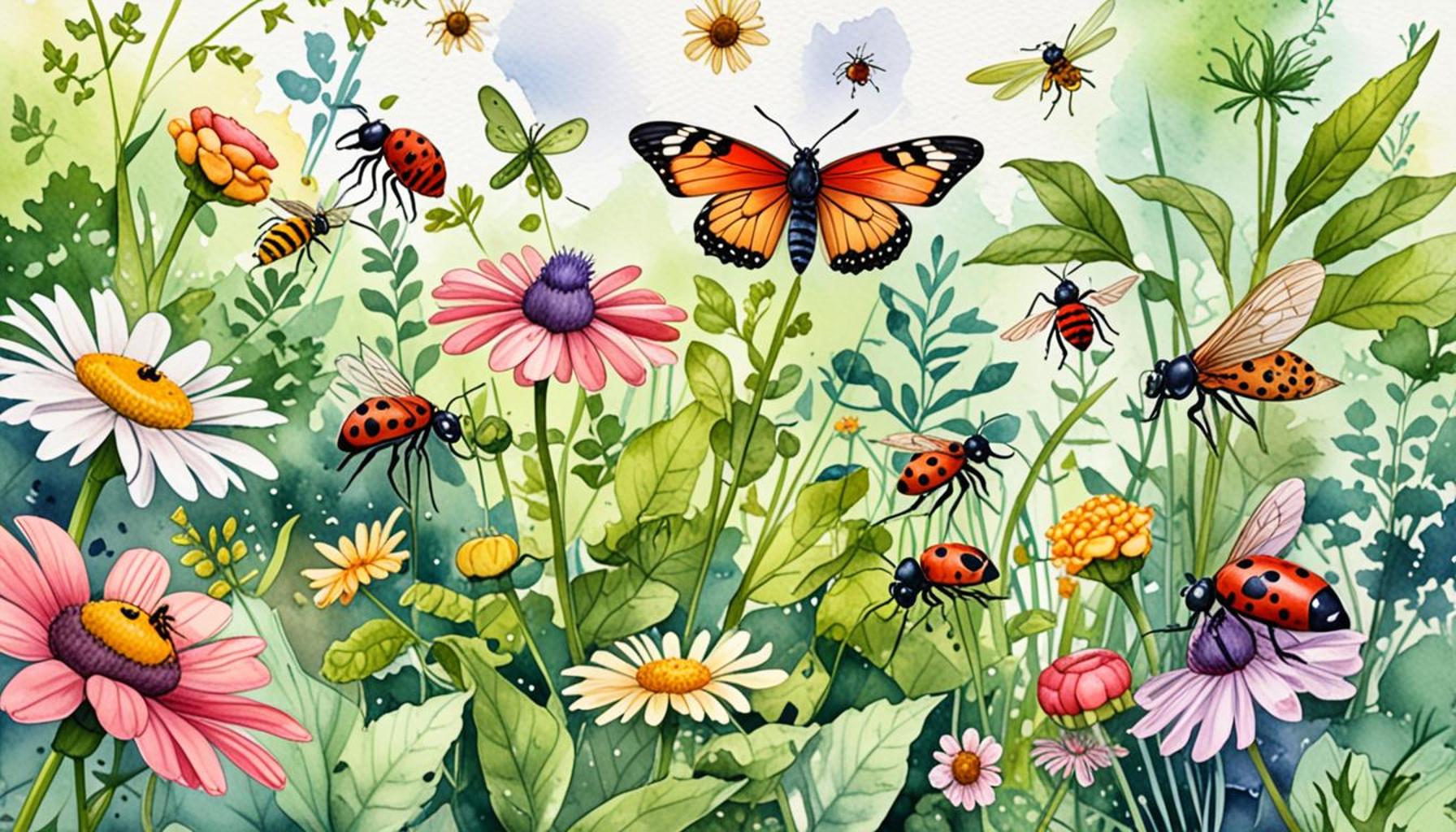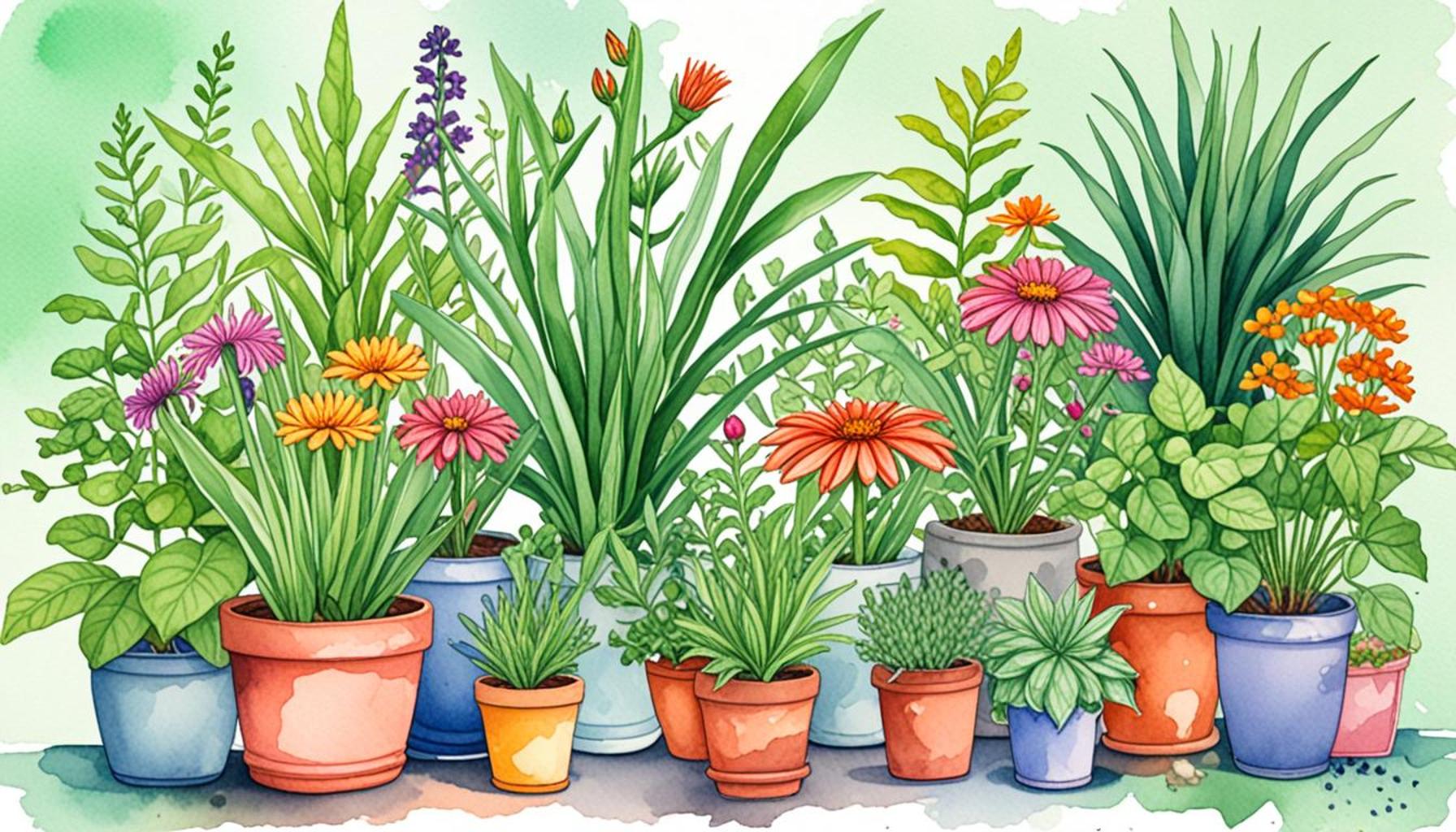The Role of Beneficial Insects in Controlling Garden Pests

Harnessing Nature’s Allies for a Healthier Garden
Gardeners often face a significant challenge: keeping pests at bay while promoting healthy plant growth. What if the solution lies in the very ecosystem of the garden itself? Beneficial insects play a crucial role in pest control, often providing natural alternatives to chemical pesticides. Surprisingly, these tiny allies can dramatically shift the balance in a garden, transforming it into a haven of biodiversity and resilience.
The Role of Beneficial Insects
These tiny creatures contribute to a balanced garden environment in several important ways:
- Predators: Many beneficial insects act as natural predators of common garden pests. For instance, ladybugs are voracious eaters of aphids, while lacewings feast on caterpillars and other soft-bodied insects. By effectively managing pest populations, these predators help maintain the health of garden plants without the adverse effects associated with chemical solutions.
- Pollinators: Certain beneficial insects, like bees and butterflies, are essential for pollination. Pollinators not only enhance the beauty of the garden but also lead to healthier plants and better yields. For example, the U.S. Department of Agriculture emphasizes the significant role that bees play in the pollination of fruit crops such as apples and blueberries, which directly affects the food supply.
- Parasitoids: Some insects, such as parasitic wasps, lay their eggs on or within pest insects, ultimately controlling their populations. This method of pest management can be incredibly effective because it leads to the death of the host pest, thus providing a natural and sustainable way to curb pest outbreaks.
The Importance of Fostering Beneficial Insects
Understanding and nurturing a vibrant population of beneficial insects can completely transform a garden into a thriving ecosystem. To create an inviting environment for these insects, gardeners can implement several strategies. Planting diverse crops, providing habitats like insect hotels, and avoiding the use of synthetic pesticides are just a few methods. Additionally, some plants, such as fennel, dill, and yarrow, are known to attract beneficial insects. This not only promotes biodiversity but also helps in pest management in a holistic manner.
In the quest for sustainable gardening practices, the importance of beneficial insects cannot be overstated. As more gardeners seek environmentally friendly alternatives to traditional methods, engaging with this intricate relationship can open a world of possibilities for pest management and ecological balance. By learning about and supporting beneficial insect populations, gardeners not only protect the health of their plants but also contribute to the wider health of the environment, fostering sustainability and resilience in their gardening practices.
In conclusion, making room for these essential allies in the garden invites an exciting challenge—turning a traditional gardening approach upside down in favor of a more natural and harmonious ecosystem. Whether you are an avid gardener or new to the practice, the journey towards sustainable pest control begins with understanding and embracing the power of beneficial insects.
DISCOVER MORE: Click here to learn advanced harvesting techniques
The Benefits of Beneficial Insects in Pest Management
In the intricate tapestry of garden ecosystems, beneficial insects serve as vital players in maintaining balance and promoting plant health. These insects not only help control pest populations but also contribute significantly to the overall well-being of the garden. By fostering an understanding of their roles, gardeners can harness nature’s power to create a thriving environment. Here are some key types of beneficial insects that gardeners should be aware of:
- Predatory Insects: These insects are nature’s pest police, actively hunting down and consuming harmful pests. For example, ladybugs can devour hundreds of aphids—a common garden pest—during their life cycle. Similarly, predatory beetles feed on caterpillars, slugs, and other larvae, playing an essential role in pest suppression.
- Parasitic Wasps: These small wasps are often overlooked, yet they are incredibly effective at controlling pest populations. By laying their eggs inside or on the bodies of pest insects, parasitic wasps help reduce the numbers of caterpillars and aphids. Notably, the Trichogramma wasp is famed for its success in managing moth populations that threaten crops, making them a valuable ally for farmers and gardeners alike.
- Pollinators: While pollinators are primarily celebrated for their role in plant reproduction, their presence indirectly contributes to pest management as well. Bees and butterflies, by promoting healthy flowering plants, foster biodiversity, which in turn supports the populations of beneficial predatory insects. A diverse garden attracts various insect species that work cohesively to maintain pest balances.
- Decomposers: Though not typically associated with pest control, decomposer insects, such as certain beetles and earthworms, help by breaking down organic matter, enriching the soil and creating conditions that support healthy plants. Healthy plants are more resilient to pest infestations, thus indirectly aiding in pest management.
By actively integrating beneficial insects into the garden ecosystem, gardeners can enjoy a naturally harmonious environment. This balance not only reduces reliance on synthetic pesticides but also promotes sustainable gardening practices. For instance, adopting practices such as integrating flowering plants throughout the garden, encourages a diverse range of beneficial insects to thrive. Furthermore, a healthy ecosystem is a resilient one; gardens that incorporate a variety of insect species often demonstrate increased resistance to pest invasions.
As gardeners begin to recognize the value of these insects, the appeal of embracing natural pest control solutions becomes clearer. The journey towards creating an inviting environment for beneficial insects is not just about reducing pests; it’s about cultivating a garden that flourishes with life. In this ongoing endeavor, understanding the intricate roles played by beneficial insects is crucial in paving the way for bountiful gardens.
The Integral Contribution of Beneficial Insects
The use of beneficial insects in the garden is not merely a trend but a restoration of natural balance. These insects play a pivotal role in pest management, often serving as a natural alternative to chemical pesticides. For instance, ladybugs, also known as ladybird beetles, are voracious consumers of aphids, a common nemesis for many gardeners. By introducing or nurturing ladybugs, you can significantly reduce aphid populations without resorting to synthetic chemicals.Among the ranks of beneficial insects, lacewings deserve a mention for their double role as both larvae and adults feasting on pests. Lacewing larvae, referred to as “aphid lions,” can consume over 200 aphids in a single day. This dramatic pest control showcases how a simple ecological adjustment can yield impressive results.In addition to pest control, beneficial insects contribute to the overall health of the garden ecosystem. They help in pollination, which is essential for fruit and vegetable production. For example, certain beetles and mason bees are superb pollinators, ensuring that plants yield healthy crops.Moreover, beneficial insects, such as parasitic wasps, can attack pest species in their larval stages, preventing them from reaching maturity and causing damage to plants. These small wasps can be a gardener’s best ally, reducing the need for harmful insecticides and promoting a more sustainable approach to gardening.By fostering an environment that attracts these beneficial insects, gardeners not only enhance their pest control strategies but also encourage biodiversity. Planting a diverse range of flora, including native plants, can create an inviting habitat for these insects, which is vital for maintaining a balanced ecosystem. With the correct approach and dedication to preserving these tiny creatures in your garden, your pest control efforts can develop into a more natural and effective strategy, nourishing both your plants and the environment around you.
DISCOVER MORE: Click here for insights on native plants
Fostering an Ecosystem for Beneficial Insects
Creating a conducive environment for beneficial insects is essential for encouraging their populations to thrive in the garden. Various practices can be adopted to attract these allies, ensuring that they are available when pest outbreaks occur. One effective strategy is the planting of nectar-rich flowers that provide food sources for adult beneficial insects. Choosing a variety of plants that bloom at different times throughout the growing season can ensure a continuous supply of nectar, vital for sustaining insect life.
For instance, planting flowers like marigolds, cosmos, and sunflowers alongside vegetable gardens can attract true allies, including hoverflies and lacewings. These insects are not only predators of pests, such as aphids and whiteflies, but also provide their services as pollinators. Research suggests that a well-mixed garden featuring both native and non-native plant species can bolster populations of these beneficial insects. The incorporation of native plants, known to support local insect diversity, can be particularly beneficial.
Another effective method is to minimize the use of synthetic pesticides, which can inadvertently harm beneficial insects along with their targeted pests. Instead, employing integrated pest management (IPM) approaches, such as the introduction of beneficial insects through biocontrol or the establishment of insectary strips within the garden, can yield positive results. Insectary strips, which are borders of flowering plants, offer refuge and food sources for beneficial insects, making the garden an inviting habitat.
It is also critical to maintain a variety of habitats within gardens that cater to the diverse life cycles of beneficial insects. Providing shelter is key; features like rock piles, logs, and dense plant foliage can serve as overwintering sites and protection against predators. Additionally, maintaining some leaf litter on the ground provides a perfect breeding ground for beneficial organisms, including ground beetles and spiders, which complement the insect population by targeting pest larvae.
It’s worth noting that the preservation of beneficial insect populations contributes to food security. According to the United States Department of Agriculture (USDA), roughly one-third of the food we consume relies on pollinators. As a result, by prioritizing the wellbeing of beneficial insects, gardeners can play a significant role in enhancing meal diversity and crop yields. Utilizing ecological practices that promote these vital segments of the ecosystem ultimately results in increased resilience against pest outbreaks and unanticipated agricultural challenges.
Moreover, the sense of community among gardeners has grown along with the awareness of the importance of beneficial insects. Educational workshops and local gardening clubs often emphasize the significance of these insects in pest management, fostering shared knowledge and encouraging environmentally sound gardening practices. By exchanging techniques and experiences, gardeners can collectively enhance their gardens’ health while ensuring a sustainable approach to pest management.
The interaction between plants and beneficial insects unveils both a complex relationship and a promising opportunity for sustainable gardening. Understanding this relationship is crucial for owners of backyard gardens, community gardens, and even large-scale agricultural operations. By nurturing the role of beneficial insects, gardeners not only promote their own success but also contribute to a healthier ecosystem that benefits everyone.
DISCOVER MORE: Click here to learn sustainable harvesting techniques
Conclusion
The relationship between beneficial insects and garden pest control is a vital component of sustainable gardening practices. As we’ve explored, these small yet powerful allies, including hoverflies, ladybugs, and parasitic wasps, play an instrumental role in maintaining garden health by preying on harmful pests, thus reducing the need for chemical interventions. By fostering an environment that supports their population through practices like planting nectar-rich flowers, reducing pesticide usage, and providing diverse habitats, gardeners can harness the natural balance of ecosystems for effective pest management.
Moreover, the integration of integrated pest management (IPM) approaches emphasizes the importance of beneficial insects as a key strategy for enhancing crop resilience and food security. As roughly one-third of our food relies on pollinators, promoting the wellbeing of these insects transcends personal gardening goals; it contributes significantly to the larger agricultural landscape.
By nurturing the relationship between plants and insects, gardeners not only reap the benefits of healthier gardens but also play a role in fostering biodiversity. As more gardeners embrace these ecological practices and engage in community efforts to share knowledge, the collective impact can lead to enhanced habitats that serve not just their gardens, but the entire ecosystem. Acknowledging the integral role of beneficial insects prompts us all to think critically about our gardening choices and their implications, paving the way for a more sustainable future that thrives on balance and harmony with nature.


